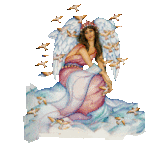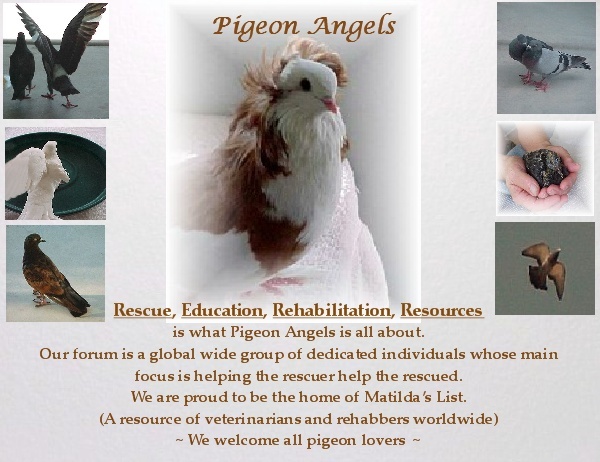|
| | Lead and Lead Paint |  |
| | | Author | Message |
|---|
Matilda
Special Pigeon Angel

Posts : 9198
Join date : 2009-01-11
Location : Pacific Northwest of the United States of America
 |  Subject: Lead and Lead Paint Subject: Lead and Lead Paint  Mon Feb 15, 2010 10:59 am Mon Feb 15, 2010 10:59 am | |
| | |
|   | | Matilda
Special Pigeon Angel

Posts : 9198
Join date : 2009-01-11
Location : Pacific Northwest of the United States of America
 |  Subject: Re: Lead and Lead Paint Subject: Re: Lead and Lead Paint  Mon Feb 15, 2010 11:01 am Mon Feb 15, 2010 11:01 am | |
| As posted by Cindy in a previous thread... Lead poisoning is the most commonly reported poisoning of pet and wild birds. Lead toxicity not only occurs in urban areas, but in rural and suburban neighborhoods as well. Clinical signs of poisoning can be variable and depend on how much lead is eaten. Symptoms include:•Loss of appetite, listlessness, weakness •Loose droppings with abnormal color (green, black, pink, bloody) •Vomiting, increased thirst• Neurological signs to include blindness, incoordination, lameness, seizuresDiagnosis of lead toxicity is made by measuring blood lead concentration. This is a simple test requiring small amounts of blood. X-rays can be helpful in making the diagnosis and determining duration of treatment. X-rays may reveal lead particles in the gastrointestinal tract necessitating a longer period of therapy. If lead poisoning is suspected from clinical signs and x-rays, treatment should begin immediately while waiting for blood lead results (which can take several days). Therapy consists of injectable medication (calcium EDTA) and supportive care for hospitalized birds. If diagnosed early, treatment is usually successful. Preventative measures should be taken to remove all potential sources of lead from your pet’s environment. All birds should be caged when unsupervised. Some items containing lead, which may be found in the environment, include: •Hardware: old paint, plaster, galvanized wire, putty, solder, batteries •Houseware: drapery weights, ceramic dishware, costume jewelry, alarm tape •Furniture: Tiffany lamps, stained glass, mirrors, wrought iron welding •Sporting goods: fishing weights, shotgun pellets If necessary, testing the bird's environment may be helpful in eliminating potential sources of lead. Call your local department of health for information on testing. Remember that prevention is the best medicine! Link to the article Lead Poisoning in Birds | |
|   | | Matilda
Special Pigeon Angel

Posts : 9198
Join date : 2009-01-11
Location : Pacific Northwest of the United States of America
 |  Subject: Heavy Metal Poisioning Subject: Heavy Metal Poisioning  Mon Feb 15, 2010 11:04 am Mon Feb 15, 2010 11:04 am | |
| | |
|   | | Matilda
Special Pigeon Angel

Posts : 9198
Join date : 2009-01-11
Location : Pacific Northwest of the United States of America
 |  Subject: Well worth the read... Subject: Well worth the read...  Mon Feb 15, 2010 11:06 am Mon Feb 15, 2010 11:06 am | |
| | |
|   | | Matilda
Special Pigeon Angel

Posts : 9198
Join date : 2009-01-11
Location : Pacific Northwest of the United States of America
 |  Subject: Heavy Metal Poisioning Subject: Heavy Metal Poisioning  Mon Feb 15, 2010 11:11 am Mon Feb 15, 2010 11:11 am | |
| HEAVY METAL POISONING:
While lead poisoning is a notorious problem, few people are aware that other heavy metals also commonly cause poisoning. Zinc and cadmium cause the same signs of illness as does lead and can easily be mistakenly diagnosed as lead poisoning. Mercury poisoning will more rarely occur. Sources of lead in the environment have diminished in recent years, but sources of zinc, cadmium and mercury have not. The incidence of heavy metal poisoning due to cadmium and zinc is increasing, and may be approaching that of lead. This article will cover the clinical signs, sources of and treatments for heavy metal poisoning in cockatiels.
Sources of Heavy Metals
The heavy metals of concern include lead, zinc, cadmium, and mercury. There are a large number of metals in all, with most being so scarce that they are of little significance. One metal, calcium, is required by the body in large amounts and is essentially non-toxic. Lead is probably the most common heavy metal that causes poisoning in cockatiels. Lead is used for its conductive properties (electrical and heat), to insulate (radiation, e.g. x-rays), to protect other metals from oxidation (hardware cloth), for its malleability (it can be molded around things like stained glass and bottles), and its heavy weight. Lead is found throughout the typical home, including:
Sources of Lead
- lead weights to keep d****ries hanging correctly
- wine bottle wraps
- stain glass windows
- behind some types of mirrors to allow them to reflect images properly
- batteries
- jewelry
- Tile and linoleum
- hardware cloth, galvanized wire
- very old paints
- lead weights in certain toys
- lead traced into the house on the soles of peoples shoes
Sources of Other Metal
Zinc, cadmium and mercury are called transitional elements. The properties of their atoms are such that they are extremely likely to react with different chemicals in the body. These reactions are often very harmful to the body. Cadmium is found in aluminum solder, plating of lead and iron, artists paints, and batteries. Because of its use in soldering and plating (to protect metals from corrosion), it is commonly found coating certain fencing and wire materials. These are often the products people mistakenly use for caging materials. Examples include wire mesh material, rabbit cage material, soldered mesh and the like. Cadmium is extremely poisonous. Mercury is less commonly available around the home. It is used in thermometers, thermostats, in certain disinfectants (mercurochrome) and antifungal agents. Mercury is highly toxic when ingested and is even toxic when it contacts skin. Some forms of mercury are insoluble (mercurochrome) and thus non-toxic. Mercury vapors are extremely toxic, often causing severe pneumonia. Zinc is used in soldering compounds, galvanized wire, batteries, and certain paints. Zinc is not very toxic. In fact, zinc is a trace element that is required in the diet. A zinc deficiency causes anemia and retardation of growth and development. Significant excesses are toxic and produce signs similar to lead poisoning.
Prevention of Poisoning
Because heavy metals are so common throughout the environment, avoidance of exposure is important. Cockatiels should never be allowed to play outside their cages without supervision. Besides heavy metal poisoning, there are many other hazards throughout the home. The environment should be inspected for the presence of heavy metals and the sources should be removed from the area if possible. Since cage and fencing materials are common sources for heavy metals, proper selection of nontoxic materials is important. Stainless steel and welded wire should be used. Cage clips should be made from alloys that do not contain lead. Toys should be inspected for lead.
Signs of Heavy Metal Poisoning
Cadmium and mercury are closely related in their biological actions as are lead and zinc. All four produce signs of heavy metal poisoning that can be indistinguishable from one another. Mercury can be divided into inorganic and organic mercury. Inorganic mercury is absorbed from the lungs and gastrointestinal tract. Organic mercury cannot only be absorbed from the lungs and gastrointestinal tract but also through the skin. Two types of mercury poisoning occur, acute and chronic. Inhalation pneumonia and sudden death occur with acute poisoning. Chronic mercury poisoning causes increased salivation, mouth irritation, bronchopneumonia (when inhaled), nose bleeds, feather loss, diarrhea, blood in the stool, kidney disease, ataxia (stumbling), and convulsions. Clinical tests may show a non-regenerative anemia (a low red blood cell count). Cadmium is toxic in extremely low levels. Because of this tests may fail to pick up a poisoning due to cadmium. Signs of cadmium toxicity are very similar to mercury and include bloody diarrhea, convulsions, and disorientation. Lead most commonly effects the gastrointestinal tract and neurological system, leading to signs associated with these organs. Diarrhea and bloody urine are common. Diarrhea is often green in color. Cockatiels often show somewhat vague signs, including fluffed appearance, loss of appetite, diarrhea, and vomiting. Surprisingly, paralysis of one leg may be the only presenting sign of lead poisoning, although paralysis of both legs is more common. Convulsions and seizures may occur. Zinc is required in the diet (an essential trace mineral) and is not toxic in moderate amounts. Excesses will cause signs of heavy metal poisoning similar to lead.
ACUTE POISONING
- Diarrhea, greenish in color
- Hemoglobinuaria, causing a rust-red color to stool
- Ataxia, a stumbling or drunk appearance
- Paralysis
- Blindness
- Vomiting
- Depression
- Convulsions and seizures
- Pneumonia when volatile vapors are inhaled, especially with mercury poisoning
CHRONIC POISONING
- All the above signs of acute poisoning
- Poor feather condition, darkened feathers, and weak feathers
- Weak and deformed beak
Diagnosis of Heavy Metal Poisoning
A diagnosis of heavy metal poisoning is often a challenge because owners are rarely aware of exposure to heavy metals. In fact, most owners will swear that there was no chance for exposure. After carefully searching the home, they often uncover the source of the poisoning. Sometimes the source is never found, leaving the possibility that future poisonings may occur. A history of unsupervised access to the house is helpful. New caging materials or owner constructed caging materials may lead to the diagnosis. An in- depth discussion of cage materials, habits of the bird (e.g. chewing on stain glass or mirrors), and types of toys present should be included in the history of sick cockatiels.
COMPLETE BLOOD COUNT: Diagnostic tests may show a mild increase in the total white blood cell count. Mild to severe anemia is present if the poisoning has been developing for a while.
RADIOGRAPHS: Heavy metal dense objects in the gizzard may be seen with some cases of poisonings. Still, there are many other objects that are normally present in the gizzard that can be equally radiodense as heavy metals. Lead can be slowly accumulated in the body from relatively minute particles, eventually causing lead poisoning. Because of this, metal dense objects are not always seen in the gizzard. In other words, the absence of metal dense objects in the gizzard does not rule out the possibility of heavy metal poisoning, and the presence of a radiodense object does not confirm the diagnosis.
BLOOD/TISSUE LEVELS OF HEAVY METALS: Blood levels of lead, cadmium, mercury or zinc can aid in the diagnosis. Cadmium must be measured carefully due to the minute quantities necessary for poisoning. Routine testing for lead, cadmium and zinc is needed in all cases suspected of being heavy metal poisonings.
Treatment of Heavy Metal Poisoning
Treatment of heavy metal poisoning in cockatiels would include the removal of excess metal from the gizzard, decreasing the blood level of the metals, and general supportive care.
REMOVAL OF HEAVY METAL FROM THE GIZZARD: If there is radiographic evidence of lead or other metals in the gizzard, attempts should be made to remove it. Feeding high fiber diets may aid in this. Metamucil can be spread onto the top of vegetables and seeds. Giving a drop or two of mineral oil twice daily may help dislodge the metal from the gizzard. If the metal persists in the gizzard after a few weeks, surgical removal may be needed. Surgery is dangerous, so it should be used as a last resort, and only after the bird has regained its strength through other treatments.
ANTIDOTE THERAPY:Fortunately, excess blood and tissue levels of heavy metals can be lowered using a product called calcium EDTA. Calcium EDTA (Calcium Versonate) is a specific antidote that grabs or binds up these heavy metal ions in the blood stream. After they are bound up, they are excreted or removed from the body. Ca EDTA therapy may need to continue for sometime till the body can pass the larger pieces of lead out of the gizzard. As previously mentioned, if there are large pieces of metal in the gizzard, treatment must continue until the metal is surgically removed.
Supportive Care
Fluid therapy is needed to support the bird until toxic blood levels can be lowered. Antibiotics may help with any concurrent infections. A high quality diet will aid in strengthening the body and replacing damaged tissues.
Conclusions
If diagnosed early, most cases of heavy metal poisoning can be cured. Some birds will die so suddenly that the owner may think he or she died of a heart attack. All dead birds should have a post mortem examination, and the owner should carefully examine the environment for signs of any chewing on cage wires, toys, walls and the like. Unfortunately, not all birds can be saved. Some will not respond to therapy soon enough, and others with severe neurological disease may recover but still have seizures or paralysis. As with all poisonings, prevention is the key.
http://www.viprasys.org/vb/f81/heavy-metal-poisoning-source-prevention-signs-diagnosis-treatment-289586/
| |  | |
| |
|   | | Matilda
Special Pigeon Angel

Posts : 9198
Join date : 2009-01-11
Location : Pacific Northwest of the United States of America
 |  Subject: Lead Poisioning in Birds in Europe Subject: Lead Poisioning in Birds in Europe  Tue Feb 16, 2010 9:12 pm Tue Feb 16, 2010 9:12 pm | |
| | |
|   | | Matilda
Special Pigeon Angel

Posts : 9198
Join date : 2009-01-11
Location : Pacific Northwest of the United States of America
 |  Subject: Re: Lead and Lead Paint Subject: Re: Lead and Lead Paint  Tue Feb 16, 2010 9:15 pm Tue Feb 16, 2010 9:15 pm | |
| | |
|   | | Teresa
Administrative Member

Posts : 5381
Join date : 2009-07-23
Location : Portugal
 |  Subject: Re: Lead and Lead Paint Subject: Re: Lead and Lead Paint  Tue Feb 16, 2010 9:52 pm Tue Feb 16, 2010 9:52 pm | |
| Thanks for the link, Charis.
It seems that in this case the source of the lead must be air pollution by vehicle exhausts. I wonder how many cases of depression and other pathologies of people living and working in busy cities are due to lead poisoning too. It will be a happy day for all species when city centre pollution is tackled. | |
|   | | Matilda
Special Pigeon Angel

Posts : 9198
Join date : 2009-01-11
Location : Pacific Northwest of the United States of America
 |  Subject: Wikipedia article on Lead Paint Poisioning In Humans Subject: Wikipedia article on Lead Paint Poisioning In Humans  Fri Feb 26, 2010 11:44 am Fri Feb 26, 2010 11:44 am | |
| | |
|   | | AZWhitefeather
Owner/Administrator

Posts : 10863
Join date : 2009-01-11
Location : Arizona Southwestern United States
 |  Subject: Re: Lead and Lead Paint Subject: Re: Lead and Lead Paint  Fri Feb 26, 2010 2:46 pm Fri Feb 26, 2010 2:46 pm | |
| Pretty scary, that's for sure.  | |
|   | | Matilda
Special Pigeon Angel

Posts : 9198
Join date : 2009-01-11
Location : Pacific Northwest of the United States of America
 |  Subject: Worth the read Subject: Worth the read  Sun Mar 07, 2010 9:01 pm Sun Mar 07, 2010 9:01 pm | |
| | |
|   | | AZWhitefeather
Owner/Administrator

Posts : 10863
Join date : 2009-01-11
Location : Arizona Southwestern United States
 | |   | | Sponsored content
 |  Subject: Re: Lead and Lead Paint Subject: Re: Lead and Lead Paint  | |
| |
|   | | | | Lead and Lead Paint |  |
|
Similar topics |  |
|
| | Permissions in this forum: | You cannot reply to topics in this forum
| |
| |
| |


